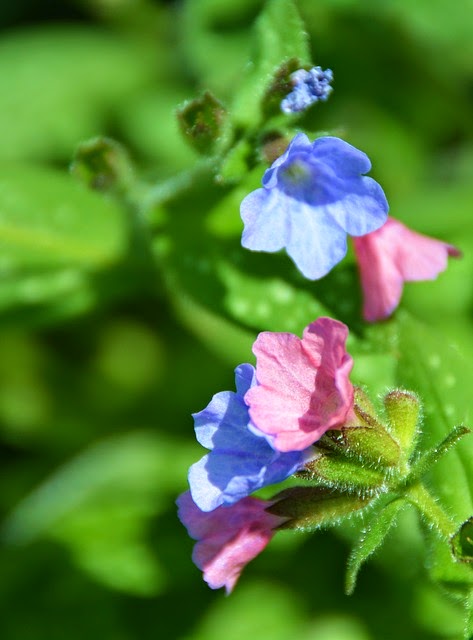Grown in medieval England Pulmonaria or Lungwort as it is commonly called, was used as
a herbal remedy to treat respiratory problems. This is because the white blotches on the plants leaves were thought by the people of the time to resemble the alveolar cavities of the lung. The plant has the Genus name Pulmonaria, which is from the Latin word pulmo meaning lung. There are many cultivars of Pulmonaria, but probably the Officinalis is the one most commonly found and indeed planted by me in my various gardens here in North Hampshire, England.
They grow well in a partially shaded border or indeed full sun and flower from early March through April here. The flowers open pink but soon turn a blue/mauve as they mature. It is a good plant to provide ground cover if required because they spread and clump reasonably quickly.
This herbaceous perennial needs little maintenance except the removal of dead leaves. It can be beneficial to divide larger plants after a few years, best done in the Autumn
General discussion and your views are welcome please say hello. I regret however because of my busy schedule, I am unable to answer many questions. Sneaky advertising will be deleted sorry. Thanks so much for visiting my blog today.
This herbaceous perennial needs little maintenance except the removal of dead leaves. It can be beneficial to divide larger plants after a few years, best done in the Autumn
General discussion and your views are welcome please say hello. I regret however because of my busy schedule, I am unable to answer many questions. Sneaky advertising will be deleted sorry. Thanks so much for visiting my blog today.




6 comments:
Simon, I think I'm the only person on the planet who cannot grow this "easy-to-grow" perennial. Was sent a marvelous sampler of 8 different varieties from Terra Nova - the only thing left is the tags. The most discouraging pulmonaria tale was when I killed a gift plant from stock that had orginally come over from England to Newfoundland some 350 years or so ago. Better declare my garden a lungwort-free zone.
Hi Barbara, Oh dear seems your pulmo' adventures have not proved very successful. I guess we all have 'disaster' plants that we just cannot get on with. Sad your going to have a lungwort free zone, maybe you will have a try with them again sometime. Nice to hear from you, best wishes, Simon
I'm not familiar with the lungwort, but it is very beautiful. Maybe someday when I have a big garden I'll give it a try. Thanks for the history on the plant. Quite interesting. Cheeers!
Hi there over at City Diggity, Thanks so much for the comment. I'm glad you found this article interesting. Best Wishes, Simon
Simon - hi
I have a lungwort which seems to be the favourite tea time treat of every insect/slug/snail in the garden. We've had to resort to putting a copper ring around it - even course gravel didn't do the trick - to deter the nibblers. I am a herbalist and cannot use leaves which have been nibbled, so I'm having a real struggle to get anything off it that I can use in my preparations. Do you happen to know who's nibbling it and what I can do to stop the little b*ggers??
Many thanks - Gina Smith
Hi Gina, Sorry to hear you are having trouble with unwanted visitors to your lungworts. Try a couple of beer traps for slugs and snails. Simply bury a jamjar in the ground with the top at soil level. Then half fill with beer (in UK we use bitter but any brew should be fine.) The slugs/snails should drop in for a drink quite literally and save some of your precious leaves for your herbalism.
Good luck, and thanks for dropping me a line. Simon
Post a Comment